“…punctured lung and the start of a serious bacterial infec– Captain, are you listening to me?”
I felt profoundly awful. I blacked out almost as soon as I got off the oxygen rich suit mix and back onto shipboard air, and when I woke up I was on the exam table in Doctor Tannehill’s little infirmary.
“Ugh,” I groaned, “sorry, I think I drifted off.”
Tannehill shook her head like a disapproving parent – an effect that would have been more effective if she wasn’t fresh out of her surgical residency. I must have been awake but not really awake because I had no recall of the conversation she’d been having until that moment.
“I was saying, the field medkit is mostly just stimulants and painkillers. It’s designed to get you mobile so you can exit a dangerous solution. It’s not a substitute for first aid. By the time you got back, you not only had that first gunshot wound, but you’d acquired second degree burns, a punctured lung, and the start of a serious bacterial infection. You’re lucky to be alive.”
“On the other hand,” Moara started to say. I snapped my head to the left and realized my first mate was standing right next to me.
“How long have you been here?” I asked, maybe a little more snappily than he deserved.
Moara smirked. “About half an hour. I can to check in with you after we settled into the landing zone.”
“The landing zone? How long have… you know, never mind. You were saying?”

“We’ve got a lot of catching up to do, but the bottom line is that you gave Ecliptic a hell of a bloody lip. When we got to orbit, it was swarming with ships but they were completely uncoordinated and Sam was able to break away like it was nothing. Major Sanon thinks you probably barged in on a meeting of their leadership and… well, you were there.”
“We wiped ’em out,” I confirmed.
“Yeah. So short term I think we’re in the clear – they’re going to be sorting out their own house rather than chasing us. Though sooner or later I’m sure they’re going to be looking for payback.”
“Occupational hazard,” I agreed. “But what’s this about a landing zone?”
“Alright, so we’re not in Jaffa any more. Jazz executed an emergency jump to Delta Vulpes – it went about as well as we could have hoped, but we’ve had to touch down on Delta Vulpes III for repairs – and to set up that fuel extractor.”
I nodded slowly. “With the switchback we did and then the emergency jump, we must be close to empty.”
“Yeah, close enough that we can’t get back to Jaffa even. If something goes wrong with the fuel extractor, our only real option is to squeeze out the last few kilograms of helium to make it to the fallback site on Gamma Vulpes II-a, then wait until Walter sends someone looking for us.”
“Sounds like I need to be out of this infirmary and out there with Lin and Heller setting up the extractor.”
“Forget it,” Tannehill broke in. “You’re on enforced bed rest. Not even light duty. Just take it easy and let the antibiotics do their work.”
I looked to Moara to back me up, but he just nodded in agreement with the doctor. “Fine, bed rest it is. Anything else I need to know about?”
“Actually, yes. You know those transit cases you hauled back?”
I nodded, and Moara continued. “Those are… pretty hot. Sentient AI adaptors and xenowarfare tech, in particular. Very illegal stuff. You probably gave Ecliptic another black eye by swiping them, but we need to keep those under lock and key and hand them over to the proper authorities as soon as feasible. We do not want some random Freestar Sec customs boat picking them up on a routine scan.”

“Lock them up in the shielded cargo pod,” I said. “We’re going to have to hang onto them until the return leg of the trip, but once we get back to the Settled Systems I’m sure Hadrian can facilitate us handing them off to the TMD.”
That’s the Terrormorph Management Division, if you didn’t know. They’re a UC Navy task force that works to prevent the eponymous invasive species from getting a foothold on human-occupied worlds. Because of international sensitivity about xenowarfare research, all their operations have observers from the Freestar Collective, which makes them Constellation’s go-to organization for handing over any illegal weapons or restricted dual-use technology we come into possession of. But that would have to wait, since we were a long ways from the TMD’s base on Mars.
Landing Site, Northern Hemisphere
Delta Vulpes III
Delta Vulpes System
Captain’s Log, June 29th, 2330. I hate the waiting. Sitting in my cabin reading reports while Lin and Heller build the helium extractor, while Jazz and Sam work on fixing up the grav drive, while Cora and Barrett conduct a mineral survey. I don’t regret leading the strike on Vulture’s Roost, but the consequences are a sharp lesson on the dangerous of kinetic action. Fortunately, the ship is in good hands under Commander Otero’s supervision, and my health has been steadily improving under Doctor Tannehill’s care. I’m eager make the final jump to Enlil as soon as we’re adequately fueled.
With my binoculars set to maximum magnification, I could just see the fuel extractor. We’d taken advantage of Intrepid‘s large cargo bays to bring prefabricated parts for the main assemblies, and that sped up construction significantly. With an ambient temperature of -141 degrees Celsius, the work had to happen in shifts – Heller floated the idea of setting up a small habitat at the work site, but Lin squashed it, pointing out that the time savings on the main project wouldn’t offset the extra work needed to erect the hab.
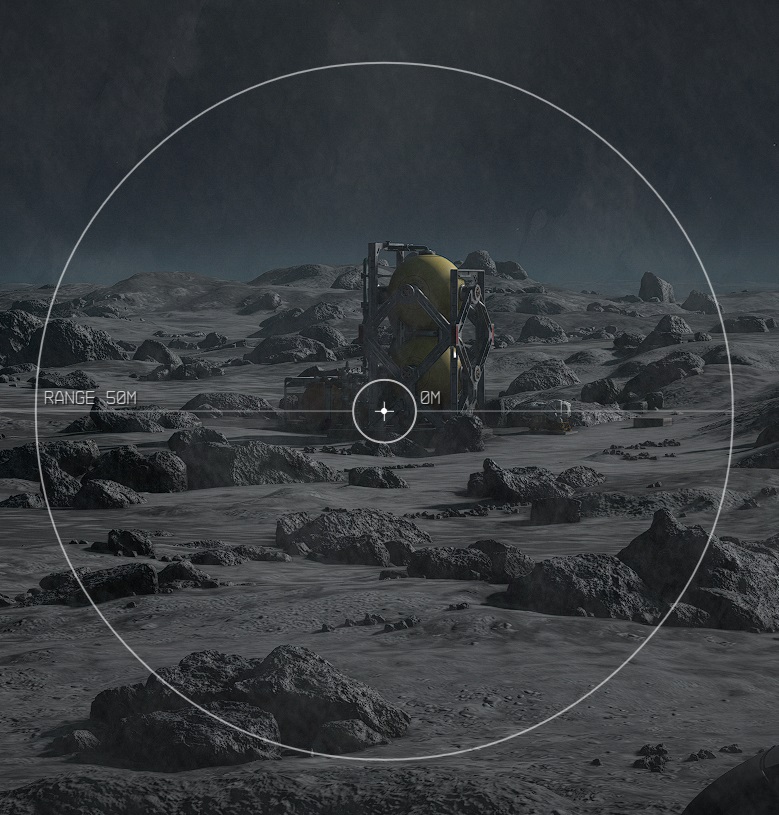
The main challenge turned out to be power. We’d originally planned to set up solar collectors, but the light from the system’s K2 star just wasn’t enough to make it an efficient use of resources. Instead, Heller set up a very small fusion generator that could run off helium-3 siphoned from the collection bunker. Of course, that required a starter supply, which had been a bit of an adventure in its own right.
Working from Cora and Barrett’s survey map, Heller identified a surface vent that was outgassing helium. With great care – since working with pressurized gas was always risky even under the best of circumstances – he tapped the vent and gathered enough He3 to run the portable generator long enough to start filling the collector stack. From there, the fuel collector should be effective self-powering over the timeframe that we cared about.
That left us in a bit of a waiting game. We’d burned through about 90% of our 500 kilograms of helium-3 so far. Our calculations showed that the round trip from here to Enlil would require about 140 kilograms, and I wanted us to have twice that in our tanks in case we ran into complications, so we’d be waiting for a while while the extractor did its thing. Then we’d leave it to run while we visited Enlil, stopping in after to refuel again for the trip home.
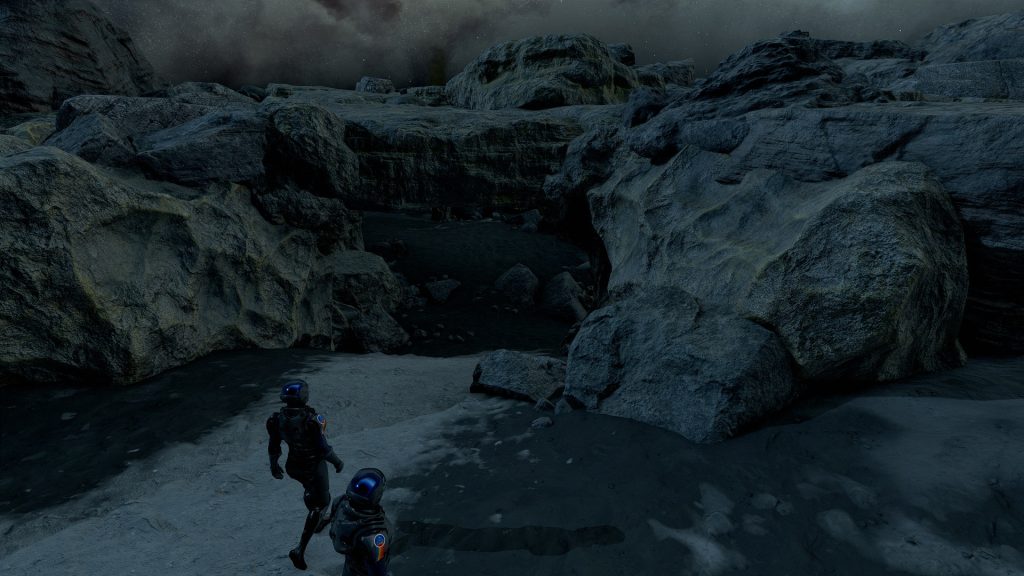
During that downtime, Barrett and Cora made an interesting discovery. About half a kilometer from the landing zone, unusual scanner readings led them to a partially covered crater, the contents of which didn’t match the general minerology of the area. Notably, it contained small but significant deposits of silver and uranium.
Barrett took advantage of the opportunity to give Cora some hands-on time using a laser cutter, and the two of them returned with samples of what Barrett suspected were fragments of the meteorite that caused the crater.
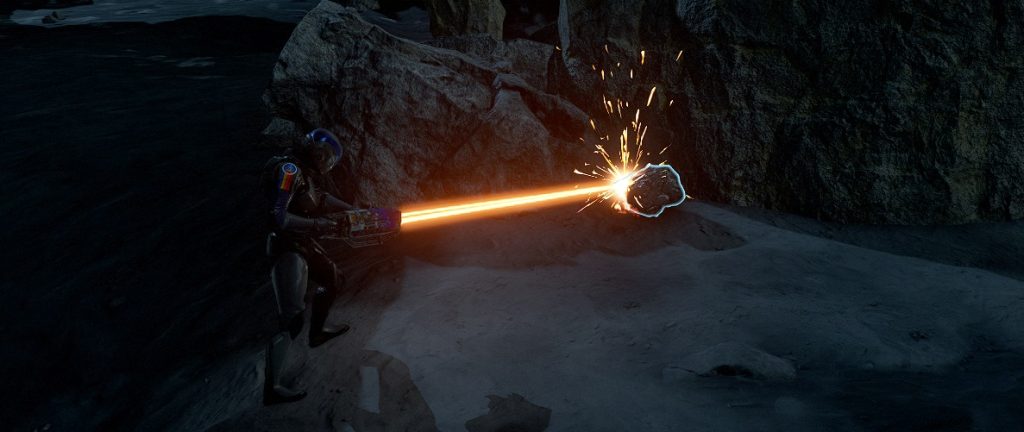
And that had just turned out to be a foretaste of what was to come. The next day, those two came across another anomaly. It was another crater, this one open-faced, but encrusted with towering crystal growths. Evidently, the impactor had contained minerals that were able to act as seed crystals, slowly growing larger and larger over time until they reached the great heights that Barret and Cora observed.
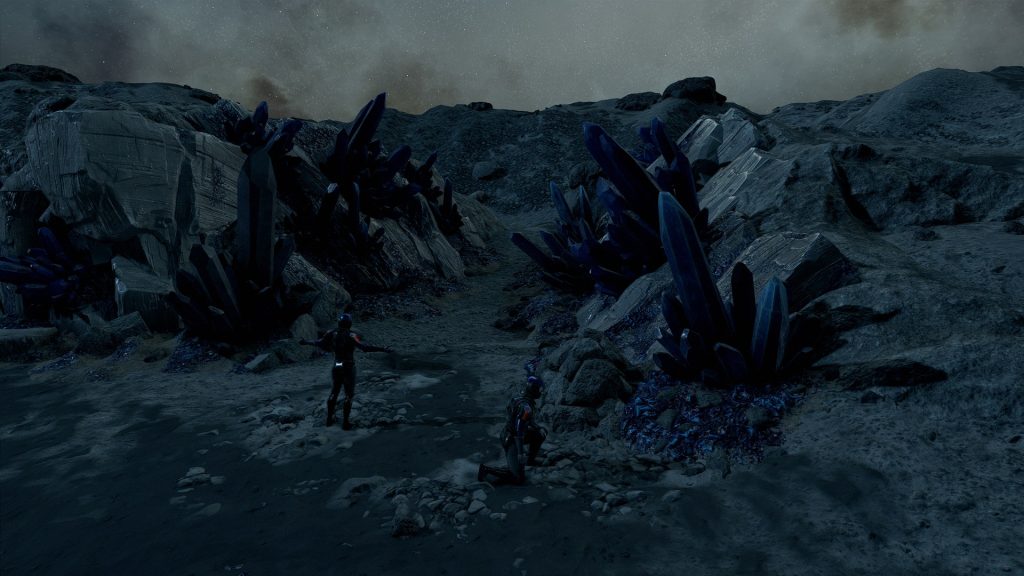
Had Constellation been in the drug-dealing business, we might have found that discovery even more exciting: analysis of the crystal samples that Barrett brought back with him showed that they contained organic compounds that would act as powerful hallucinogens in human biochemistry. Wisely, Barrett elected not to test his discovery, instead merely adding the samples to the cargo hold and annotating the survey log.
This did however lead to me getting drawn into a bit of a family squabble in my office upon their return.
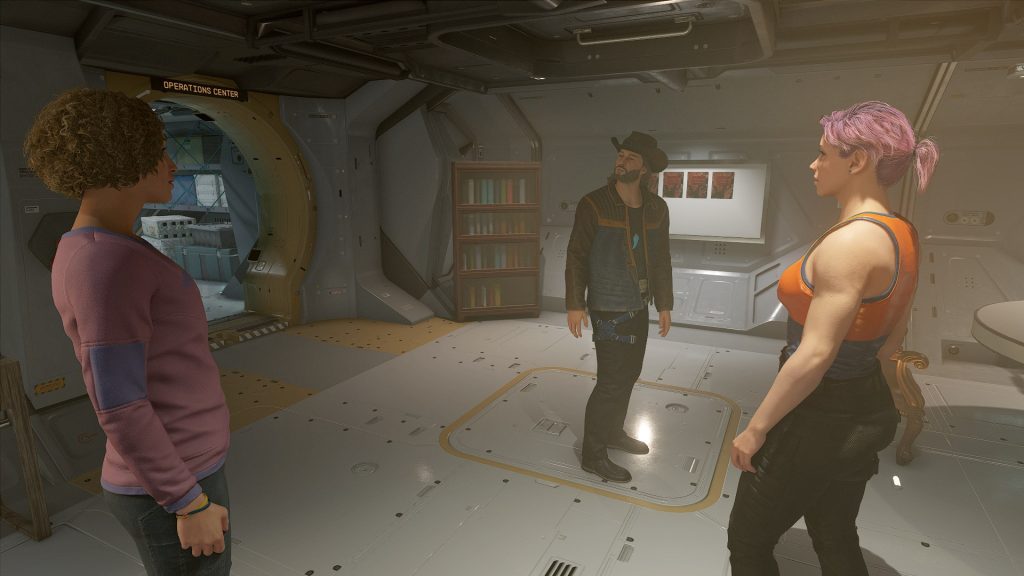
“When Barrett said you’d be helping with the survey work, I thought he mean you’d be using the scanner, not climbing into caves or operating a mining laser,” Sam was saying as the two of them walked into the office.
Cora seemed decidedly unimpressed. “Dad, stop pretending you’re mad at me. I know you’re not.”
“Exactly, I’m not mad at you. I’m mad at Barrett. He’s gotta remember that you’re still a trainee.”
“Is there something I can help you two with?” I asked as they further entered my personal space.
Sam spoke first, “I want you to set some boundaries with Barrett when he’s ‘training’ Cora. He’s letting her do stuff that she doesn’t have the experience to do safely yet.”
Cora was quick on his heels, “and I want you to tell my dad to back off. Politely. I appreciate what he’s trying to do, but I’m an adult, and I’m here to learn how to do… Constellation stuff. Barrett’s teaching me things I need to know.”
We talked through what was going on, and both of them had some valid points. Barrett had been playing a bit fast and loose with Constellation’s training and certification procedures, having Cora do tasks that she wasn’t rated for. On the other hand, Cora correctly pointed out that she was ahead of the curve in a lot of those skill areas, even if her official records didn’t show it, because she’d been accompanying Sam on missions for so many years. That de facto apprenticeship put her ahead of where a fresh recruit would be on their first voyage.
I promised them a decision by the end of the day, but before I laid down he law I wanted to talk to Sarah. As the Constellation chair, she was really the one with the authority to decide this.
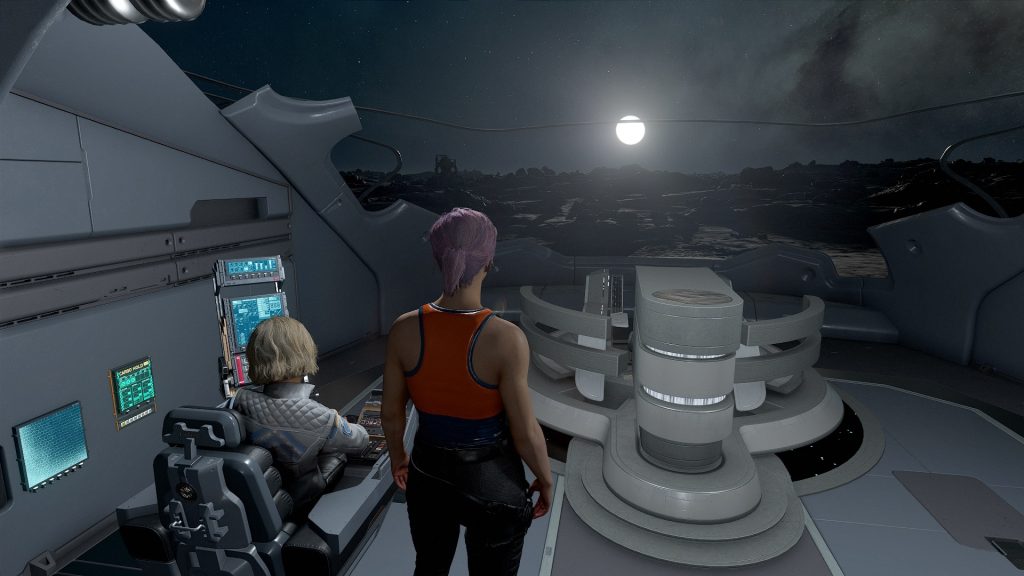
Sarah was covering the bridge watch on the command deck, and in tracking her down I got a chance to witness a rather spectacular sunset. I took a second just to appreciate the shadow-clad landscape before raising the issue.
Sarah was sympathetic with Cora’s position, but she agreed with Sam – the certification system was set up for a reason, and the reason was keeping recruits alive. She told me she’d talk to Barrett and end the unauthorized ‘practice’ work, but she also promised to spend some time with Cora and figure out where she realistically stood on her skills. She acknowledged that Cora probably already qualified for a number of certifications, and there was little to gain from holding her back.
Neither of the two Coes especially liked that answer, but they accepted it. Just as well, too, since Barrett was apparently planning on visiting a cave he’d detected on their last run, and spelunking was definitely not something trainees were supposed to be doing. Fortunately, I’d finally got a clean bill of health from Tannehill that afternoon, so I told Barrett I’d accompany him instead.

I could understand Barrett’s curiosity about the cave. It was sunk into a low ridge – probably would have gone totally unnoticed except for the occasional plumes of gas rising out of the entrance.
“Any reading on the outgassing?” I asked him.
Barrett shook his head, “too diffuse for the scanner to get a good read. I’m hoping there are some nice big vents inside that we can get samples from.”
“Well, damn. I wasn’t expecting that,” Barrett said once we got inside.

The cavern was completely filled with the hallucinogenic crystals that him and Cora had found the other day.
“You know, Captain, I think I’m revising my theory about that crater being the product of seed crystals from a meteor. These crystalline formations might be an emergent property of Delta Vulpes III’s natural geology. Let’s give this place a closer look and see if we can learn more.”
We descended into the shallow bed of the cavern; wisps of gas were rising up from the floor, and Barrett captured a few samples from rock fissures where the outgassing was a bit more intense. Once those samples were secure, we started to push in a little deeper into the mine when my suit’s Geiger counter started to tick up.
“You getting that, Barrett?”
“Yeah,” he said, “I don’t think it’s local. Might be a solar radiation event. Should we head back or shelter in place?”
“Better get back. We don’t know how long we’ll have to shelter and I don’t know if I want to put the suit heaters to the test for hours on end.”
Back on the ship, Sam gave me… well, not bad news, but complicated news. The solar event was going to last for several local days, and it would only grow in intensity over the short run. He recommended limiting excursions to nighttime hours only, and I agreed with him.
When I tracked down Barrett to let him know, he was waiting with the preliminary results on his samples.
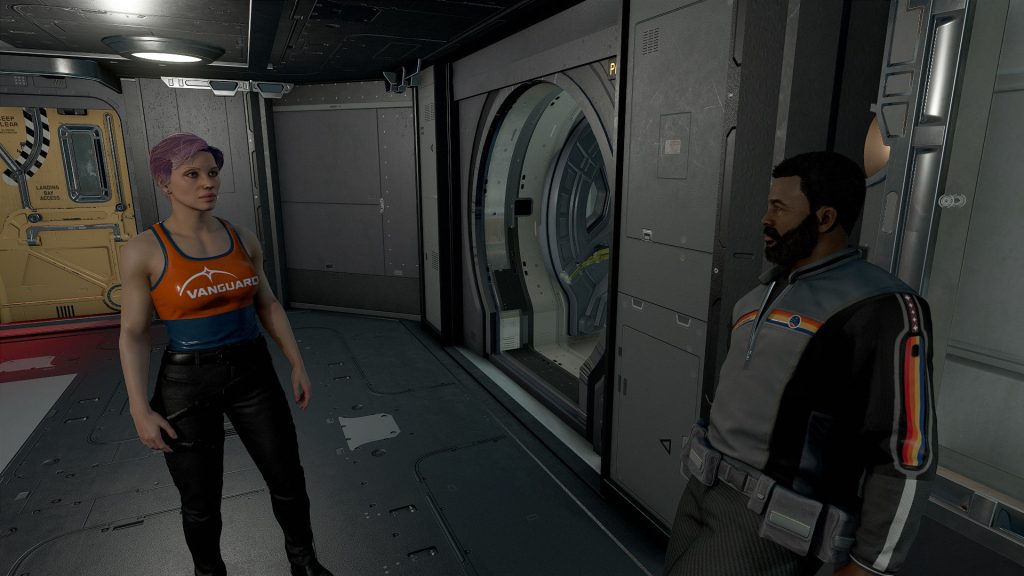
“So these berylcyclohexylamine crystals,” he said, “the seed crystal meteor theory was a total red herring. The gas we saw – ammonia. Good old NH3. The missing piece of the recipe, I think, was that liquid we saw dripping from the cave roof and from some of the crystals in the cave. We bugged out before I got a sample, but my bet is that it’s an organic compound closely related to cyclohexane. When those two components come into contact with beryllium – like in the depots we saw both in the cave and in the crater – the crystals start to form.”
“OK,” I said, “but you didn’t see any of the liquid component in the crater.”
“No, and I bet if we went back and examined the crystals there, we’d find they weren’t growing anymore. I think that ‘crater’ started its life as one of these caverns, but at some point the roof collapsed, leaving some of the crystals exposed through the surface rubble. Then give it a couple million years for the regolith to smooth out… and you end up with something that looks a lot like a meteoric crater.”
“Sounds like you’re going to have an interesting survey report to write for Vladimir,” I suggested.
“Yeah, but I’d like to go back and get some fluid samples to confirm my theory. Mind if I borrow the rover once the sun goes down?”
“It’s all yours,” I agreed, “but don’t go off alone. Caves are a strictly two-person-minimum activity.”
“That’s fine,” he said. “I’d like to bring Heller along with me anyway to get his opinion on the geology.”
Heller had been babysitting the helium extractor, but by this point the self-sustaining arrangement for the generator was going smoothly and it was just a matter of waiting for the fuel to accumulate in the storage tanks. We’d pulled about 50 kilograms out of the ground so far, when meant we’d be staying on Delta Vulpes III for several more days. With the extractor settling into a reliable routine, Heller was more than happy to break up the monotony by accompanying Barrett.
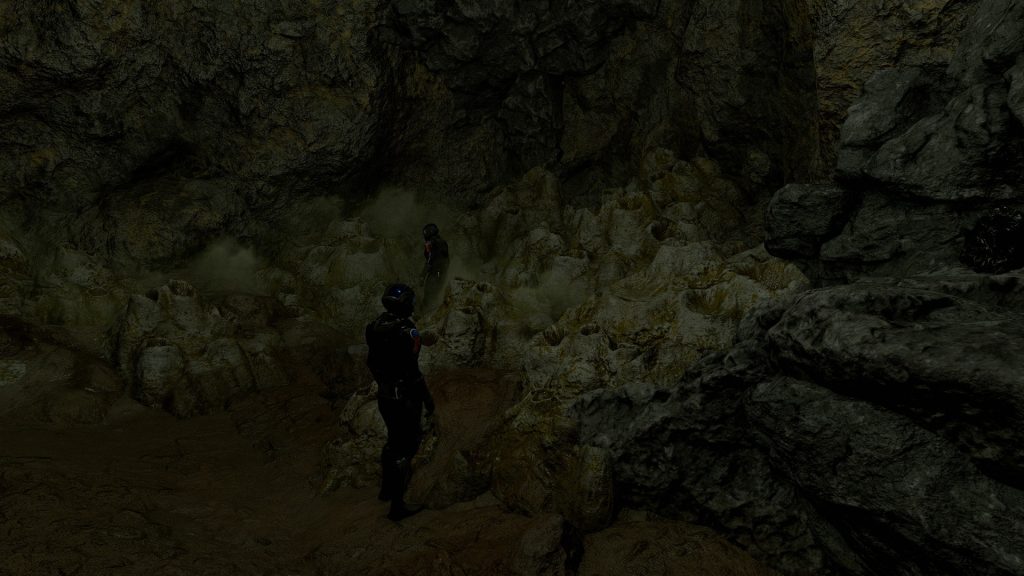
Their follow-on trip yielded some more answers. With some help from Heller, Barrett found a really extensive ammonia vent that not only yielded better samples but revealed that the vents were also releasing a precursor chemical to the cyclohexane-relative, which in turn was catalyzing with the minerals in the cave ceilings and then depositing back down to grow crystals on the beryllium deposits.
I was a little less impressed – and Doctor Tannehill was significantly less impressed – when the two of them didn’t return until after sunrise and managed to pick up a nasty sunburn from the solar radiation.
“I’ll be fine,” Barrett said as Tannehill applied medicated cream to the back of his neck, “hundreds of thousands of years of evolution have graced me with this gorgeous density of melanin for just such an event.”
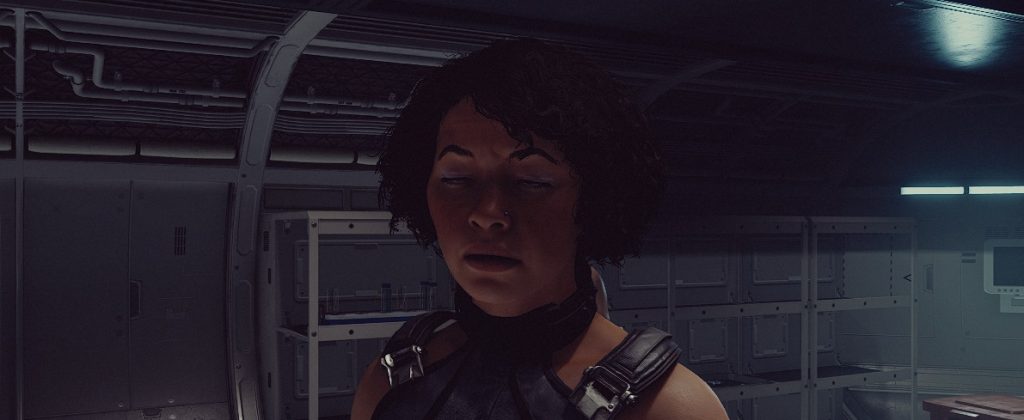
“First off,” she said while rolling her eyes, “your melanistic skill clearly did not protect you, or else I wouldn’t be treating you for radiation burns. And before you say ‘oh it’s just a sunburn,’ no, it’s a radiation burn, and it carries all the long-term health risks that any other radiation exposure event carries.”
“Second,” she rolled on before Barrett could get a word in, “Heller does not have your same skin complexion, and your violation of the Captain’s work restrictions exposed him as well.”
“Yeah, I’m itching all over. You about ready for my turn, Doc?” Heller chimed in.
Barrett looked a little abashed, but offered, “for what it’s worth, I planned to be back at the ship in time. Neither of us could have expected how deep the cave would run, and the vents we found down there was the missing link that solved the whole ‘magic crystals’ mystery.”
I’d kept silent during this exchange, but felt I needed to get in a word edgewise. “Doc’s right, Barrett. I agree that you made a really important find, but you had enough time to come home and finish your delve tomorrow. No more ops after sunrise, no excuses. Got it?”
“I got it,” he relented.
After he’d recovered from the burns, Barrett did take one final trip on the rover, but it seemed pretty clear that he’d already had all his big breakthroughs. Satisfied that he’d been as thorough as he possibly could, he settled in to work on his survey report. At this point, we’d gathered about a third of the helium we needed, and Sarah prevailed on me to travel to Delta Vulpes V-c, one of the moons of the system’s large ringed gas giant. Despite the conventional wisdom that Delta Vuples’ moons were all far too cold to support life, her scans had detected possible biomarkers in the V-c’s thin CO2 atmosphere.
The transit across the system was uneventful, if long, and Intrepid pulled into visual range of the moon about 25 hours after departing from Delta Vuples III. But then things got… interesting. As we navigated through a small debris field on the way to our orbital insertion point, Sam reported a fire-control radar lock. Before we knew it, an unidentified ship was battering our shields with pulse laser blasts.
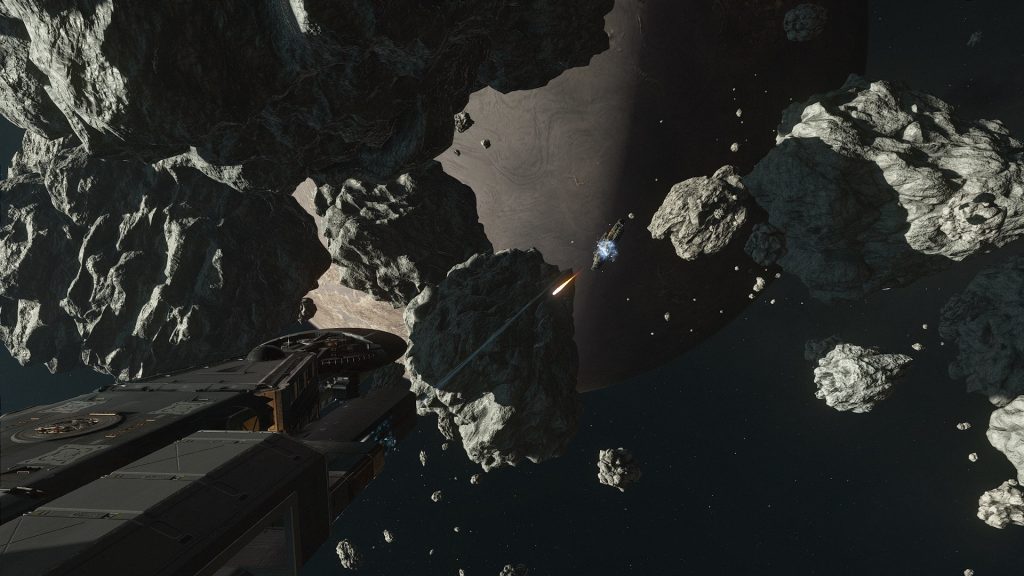
“Unknown ship, this is CS Intrepid,” I heard Sam transmitted, “cease fire, we are not hostile.”
“No response,” Sarah added after Sam repeated himself.
“Target engines,” I said. “Disable them if you can.”
The hostile ship was big, about as long as Intrepid and broader, with a catamaran design, but her systems were obviously older and probably not as well maintained. Thanks in part to the auxiliary shield emitter on our starboard hull, we were able to weather the initial pass and get into a chase position. From there, it was just a matter of battering down her shields and putting our EMP arrays to work. A few minutes later, and the ship’s engines guttered out.

While I assembled a boarding party of the combat-trained members of the crew, Sam brought us alongside and locked on our docking grapples. The other ship still wasn’t transmitting, so we didn’t take any chances breaching the ship.
Hadrian and I took the lead, and unsurprisingly we ran into immediate resistance.
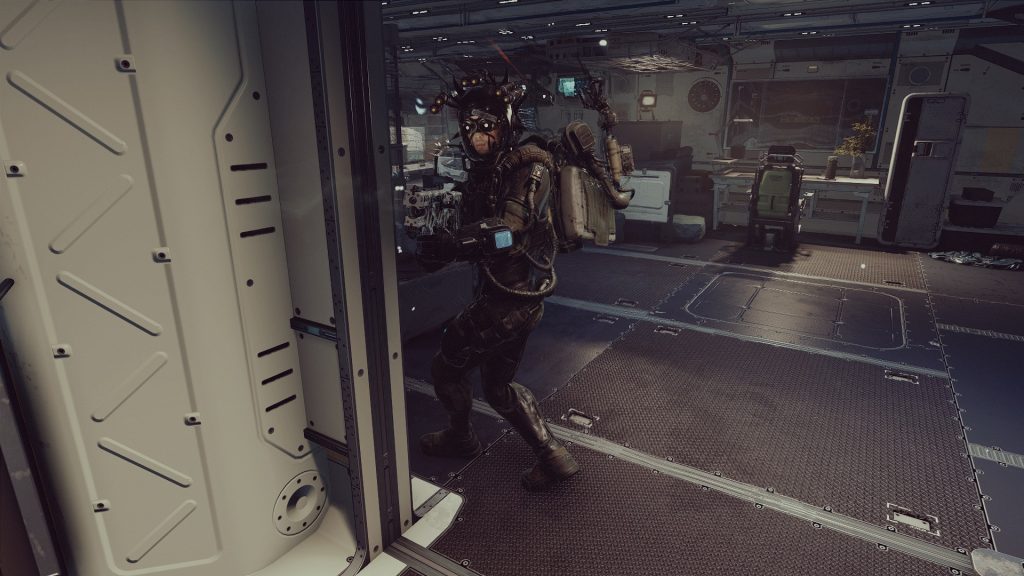
Spacers. Not named – as people commonly but wrongly assume – because they live in space, but rather for their habit of ‘spacing’ their victims. Which is to say, throwing them out airlocks. Our boarding party pressed in, putting our training to good use and clearing the ship one compartment at a time.
We knew the ship still had atmosphere, so the crew had gone in with body armor instead of full space suits, and I think that provide a wise choice. The added mobility gave us an edge over the Spacers and their bulky gear, and soon we had control of the lower decks. From there, it was just a matter of pushing down up to the command deck and seizing control.

My crew took no prisoners, but neither did any of the Spacers offer to surrender. Once we’d cleared the last compartment, we set about the laborious process of taking stock of the contents of the ship. While we were too far out to send her home with a prize crew, I was confident that the spacers’ cargo holds – or at least their fuel tanks – would yield something of value.
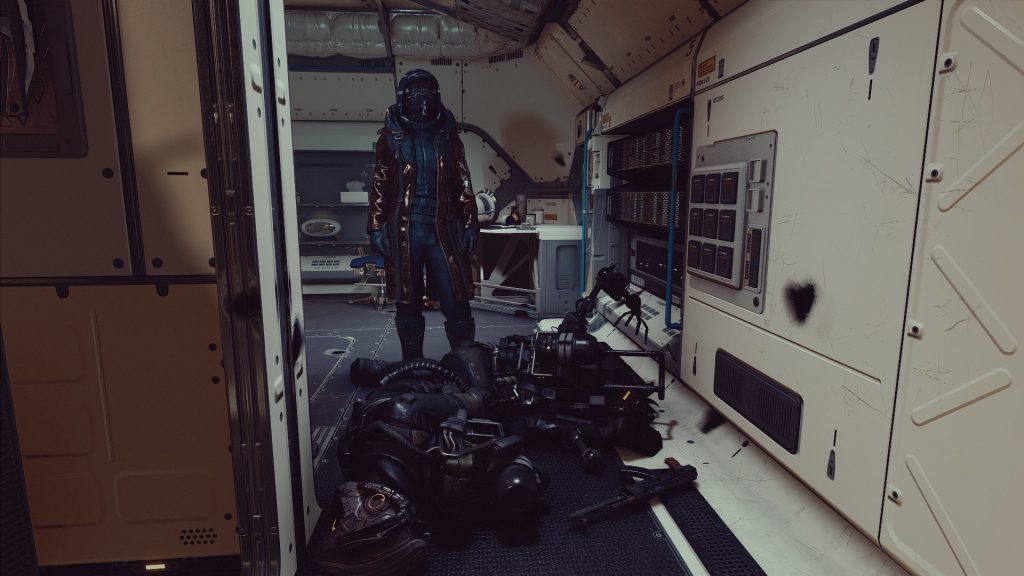
Captain’s Log, Supplemental. After becoming the unexpected owner of a Hyena class starship, the crew has taken inventory of the contents. I’ve asked Jasmine Durand in particular to prioritize an examination of the vessel’s fuel stores for anything we can transfer to Intrepid.
We confiscated the contents of the Spacers’ well-stocked galley as well as some useful parts and equipment from their engineering stores, but the real prize was in the fuel tanks. When Jasmine returned from her spacewalk, she reported that the tanks were almost completely full. As you can imagine, I got her right to work on rigging transfer pumps to move the helium into our own tanks.
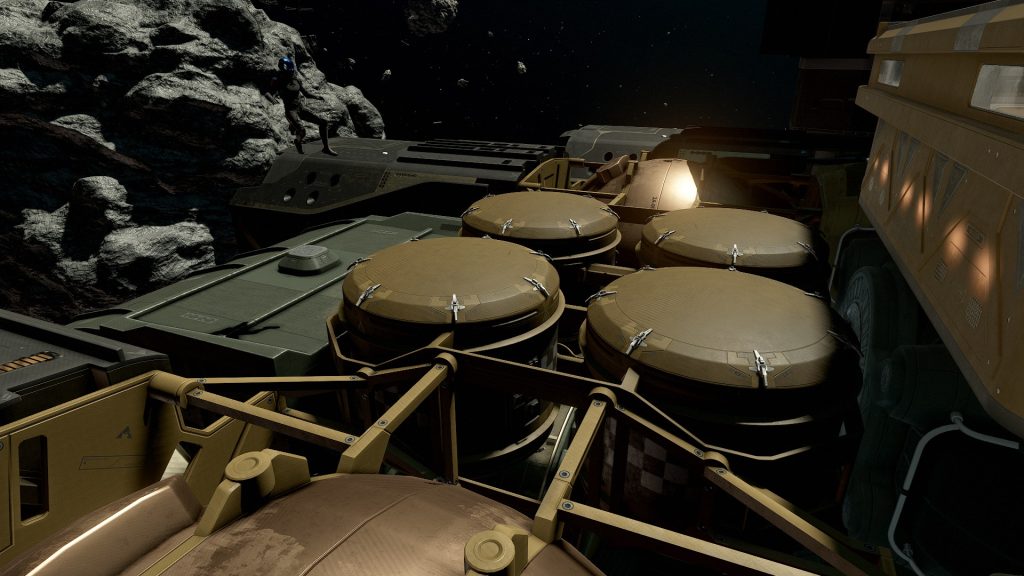
All told, we acquired over 100 kilograms of helium, enough that on our return to our extractor site we should be ready to immediately depart for Enlil. After nudging the spacer vessel into a decaying orbit to ensure we weren’t leaving behind a gift for some other troublemaker, we got to work finding a landing site on Delta Vulpes V-c.
An immediate and very interesting feature we observed from orbit was the presence of large oceans. Despite the planet’s low gravity and frigid -208 mean temperature, it had an enormous volume of surface liquid.

Once we’d set down, most of the crew took advantage of the observation deck to appreciate the view of the planet’s mountainous terrain. Vulpes V-c wasn’t the most visually striking planet we had even visited, but nevertheless I think it served as a visual palate cleanser after the ugly business of dealing with the spacers. I took advantage of the gathering to discuss next steps with Sarah, and we agreed to take the rover down the shoreline, not just to look for some of the planet’s primordial life forms but also to acquire samples of whatever made up those curious oceans.

Sarah and I piled into the rover and headed south from the landing side, but almost immediately we had to stop to take sensor readings and photographs. The reason? We’d found one of the life forms those biomarkers had hinted at. And I’m not talking worms or trilobites, these were enormous, scorpion-like creatures with iridescent shells.
“Amazing,” Sarah whispered as I slewed the scanner to get a reading on them.

“Pretty remarkable chemistry,” I said as the initial results came in. “Many oxygen compounds… in fact, the shell looks like it’s shot through with what looks a whole lot like epoxy resin.”
“If those compounds don’t become brittle at these extremely low temperatures, I wonder if they might have applications as aerospace sealants,” Sarah thought out loud.
“Maybe,” I acknowledged, “though running a farm at two hundred below sounds challenging.”
We observed a few more life forms on the way to the coast, though none as dramatic as the arthropods. Of course, the sea was dramatic in its own way. It was almost crystal clear, and surprisingly free flowing, without the slushiness I normally associate with extremely low temperature fluids. We dismounted to get some samples, and it turned out the answer was a fairly simple one.
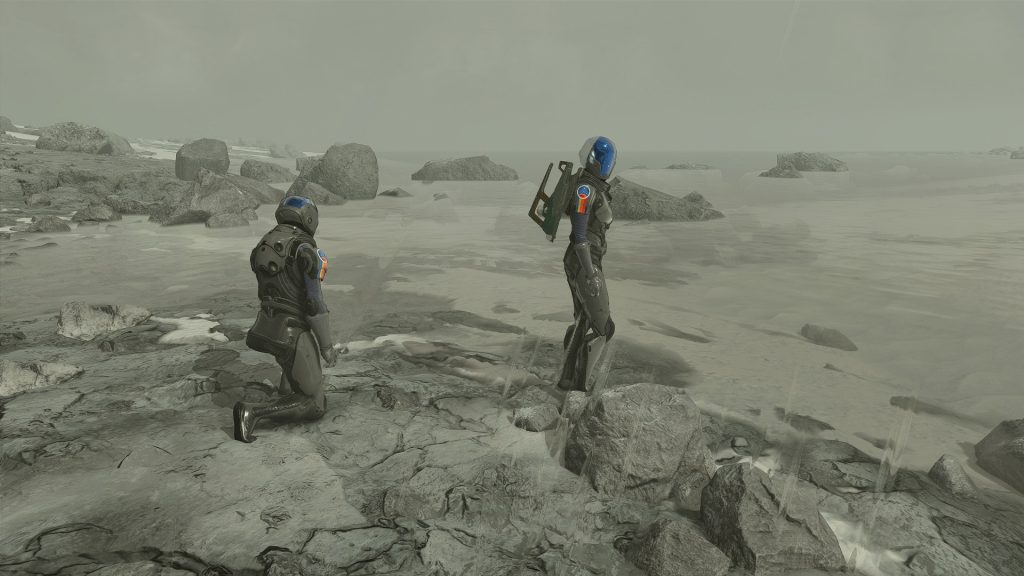
“Liquid oxygen,” Sarah said. “Not what I expected. Do you think the native creatures’ blood is also LOX?”
“Hard to say, it wouldn’t be my first expectation, but considering the number of organic oxygen compounds the scanner bounced back I wouldn’t rule it out.”
As we spoke, a gentle drizzle of even more liquid oxygen had started to spatter down on us, straining our suits’ life support and causing a pinging warning signal to sound in my ear.
“We better get back,” I said. “Though let’s keep an eye out for anything we missed with the scanner. Who knows when we’ll get another chance to visit this place.”
A few minutes later, the alarms were sounding almost continually and the rain was picking up.
“We’re not going to make it back, are we?” Sarah asked.
“No way, but I’ve got a cave on sensors, let’s hunker down and wait out this rain.”
We made it into the cave and out of the rain, but by then I was shivering badly and my heater was making a very unhealthy grinding noise.
“Ugh, I think we pushed things a bit too far with this trip,” I conceded.
“The important thing is that we got into cover. We only need to wait until the rain falls off a little, then we can make the last push back to Intrepid.”
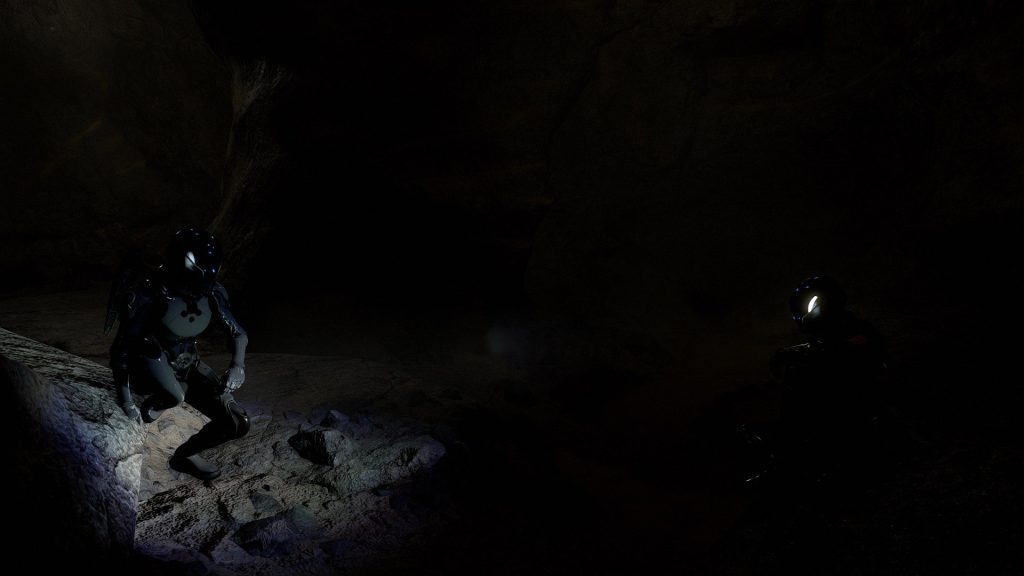
Unfortunately for us, the storm just kept getting worse and worse, and eventually we felt that we had no choice but to risk it and push the last leg to the ship. We made it, but in doing so we signed ourselves up for spending the rest of the trip back to our helium extractor getting treated for hypothermia and frostbite.
On one hand, this excursion had generated a lot of very interesting – and valuable – scientific data, but it was another example of planetary conditions quickly turning things from manageable to dangerous. I spent a good part of the return trip brainstorming on ways we could mitigate these risks, but it would be a while yet before I worked out a really viable solution.
“That wasn’t there before,” Sam said as we eased into orbit around Vulpes III. “Looks like a crash site on the far side of the planet.”
I had Sam land – we’ve got a responsibility to look for survivors – but it was Jazz and Heller who actually did the mission. I was still in no shape for adventures after the whole LOX downpour fiasco.

When they got back they told me it was pretty obvious there were no survivors right from the start, but they did their due diligence and checked anyway. At that point in the story, Jazz dropped the other shoe: they’d found a GalBank credtank in the cargo hold. With no survivors on the site, international salvage law allowed Constellation to claim ownership of the tank.
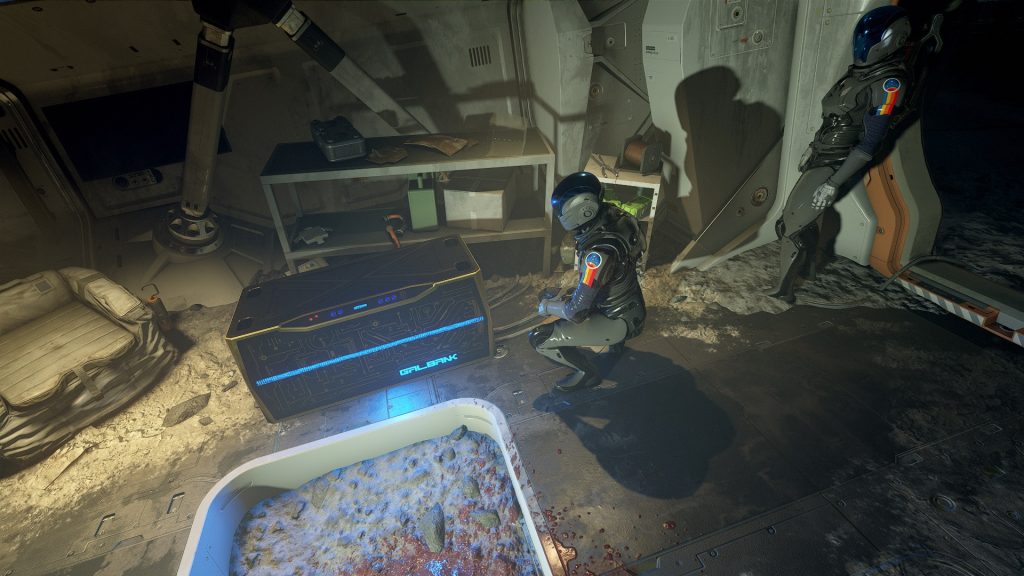
Now normally, the best we could hope to do with something like this would be to toss it in the cargo hold and return it to GalBank for a small finder’s fee. Fortunately for Constellation, I still possessed the transfer keys that I’d obtained onboard the Legacy during a certain escapade in the Bannoc system. With that key, I was able to unlock the tank and extract all the credit codes from within. That money wouldn’t do us much good out here on the frontier, but when we returned home it would make a small but meaningful contribution to getting the Dauntless built.
We didn’t stick around once Jazz and Heller got back – while sensors picked up another one of the crystal craters in the distance, I’d had my share of scientific adventure for the moment. We hopped back to the helium fueling station and got to work transferring the fuel to Intrepid. Between our pull from the extractor and what we’d claimed from the Spacers, it looked like we had enough to continue our journey.
Captain’s Log, Supplemental. Mother nature has given me a pointed reminder about the consequences of letting enthusiasm get ahead of safety in an exotic environment. Nevertheless, it seems that we’ve had more good luck than bad. Jasmine Durand reports that we now have enough fuel onboard to make a round trip between here and Enlil, with a healthy margin to spare, so the time has come to make the last outbound jump of this expedition.
End log.
July 2nd, 2330
Days Elapsed: 10
Fuel Consumption: 341.84 kg
Fuel Acquired: 191.38 kg
Fuel Remaining: 240.18
Injuries Acquired: 3
Lifetime Injuries: 4

Behind the Scenes
Grace actually acquired something on the order of 11 injuries over the course of this episode, but I streamlined and compacted it a bit for narrative purposes. When she got back from Vulture’s Roost, she had “Puncture Wound (Severe)”, “Lung Damage”, “Burns,” “Cellulitis,” and developed Pneumonia shortly after returning to the ship.
